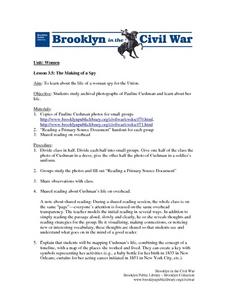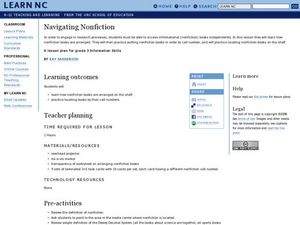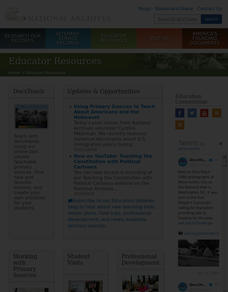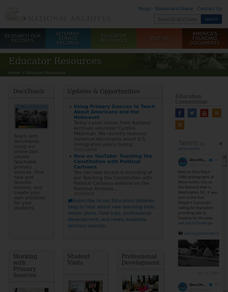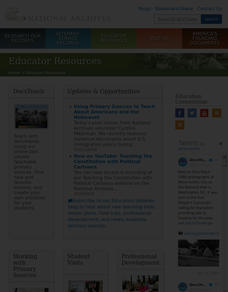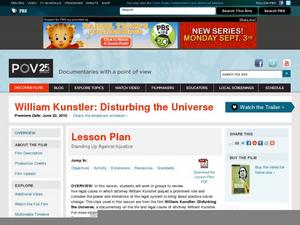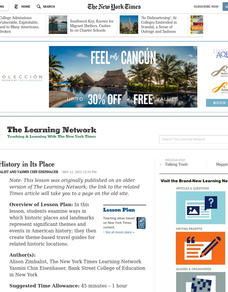Curated OER
Introduction of Primary Sources
First graders create two personal artifacts to add to a primary source shoebox that represents information about themselves. The first draw a self-portrait then build an artifact from Play-Doh and pipe cleaners to represent something...
Curated OER
Earth's Radiation Budget
Twelfth graders explore the Earth's radiation budget using Earth radiation Budget Experiment (ERBE) data archived at the IRI/LDEO Climate Data Library. They use photometers and light sources to work through several hands-on activities...
Curated OER
Lead Stories about Confederation Lesson 5
Students identify what a lead story is and how to write one, for their simulated newspaper, about Confederation. They use primary-source documents from the "EvidenceWeb" portion of the Learning Centre, on the Library and Archives Canada...
Curated OER
The Making of a Spy
Students study the life of a woman spy for the Union. They study archival photographs of Pauline Cushman and examine her life. They create a key with
symbols representing her activities (e.g., a baby bottle for her birth in 1833 in New...
Curated OER
Navigating Nonfiction
Third graders explore the arrangement of nonfiction. In this library skills lesson, 3rd graders examine Dewey Decimal classification as they collaborate to locate nonfiction materials in the library/media center.
Curated OER
Fabulous Firsts in African American History
Learners study fascinating firsts and facts and answer questions about African American history. They demonstrate abilities to research information about African American history using Internet or library sources. Finally, they use the...
Curated OER
Kirit C. Shah, M.D. v. Stan Harris and Nancy Harris Lesson 1: One Case, Two Sides
Students examine how lawyers prepare their arguments. They realize that both sides of a legal case may use the same cases as precedents in their positions. They find decisions of the Indiana Supreme Court and the Indiana Court of Appeals...
Curated OER
D-Day Message from General Eisenhower to General Marshall
Students use documents in the National Archives of the United States to evaluate the effectiveness of D-Day.
Curated OER
Cultural Inquiry Lesson 2B: Finding Artifacts and Analysis
Students build on their knowledge of sources, by looking at 2 types of information sources: artifacts or primary sources and analysis or secondary sources. They brainstorm a list of primary and secondary sources connected to one of...
Curated OER
Photographs of Lewis Hine: Documentation of Child Labor
Learners use the Archival Research Catalog to complete assignments and activities about Lewis Hines and the National Child Labor Committee.
Curated OER
Sow the Seeds of Victory!
Pupils use the National Archives and Records Administration's records to research the history of the U.S. Food Administation.
Curated OER
Memorandum Regarding the
Students use the National Archives to research the memorandum regarding the enlistment of Navajo Indians during World War II.
Curated OER
Memorandum of a Conference with President Eisenhower after Sputnik
Students use the National Archives to research how the United States and the Soviet Union south to maintain its supremacy after World War II.
Curated OER
Court Documents Related to
Young scholars use the National Archives to researcj cout coduments related to Martin Luther King, Jr.
Curated OER
Immigration and Settlement of Ethnic Groups in the Pacific Northwest
Young scholars examine ethnic history of the Pacific Northwest in the period 1850-1950. They research documents and images in digital archives to explore immigration of various ethnic groups that settled in the region during this period.
Curated OER
Autism - What Is It?
High schoolers investigate the symptoms of autism spectrum disorders, and compare expected child development with development that may indicate a diagnosis of these disorders. The final project for the lesson is the creation of posters...
Curated OER
"The Beaches of Agnes": Planning a Video Self Portrait
Agnes Varda’s autobiographical “The Beaches of Agnes,” models for young filmmakers the cinematic self-portrait. Far from “old and plump,” Varda is a giant of filmmaking and will inspire your pupils. After watching a clip of this famous...
PBS
Standing Up Against Injustice
“Sometimes things are lawful yet are actually wrong.” Researchers examine primary and secondary source materials as they study five legal cases involving civil rights attorney William Kunstler in which he attempted to use the legal...
Curated OER
Recurring Nightmares
Does history really repeat itself? Encourage your middle and high schoolers to answer this age-old question by reading the attached articles on the Cuban Missile Crisis of 1962 and the Iraq Crisis of 2002. How similar or different are...
Curated OER
Putting History in its Place
Examine ways in which historic places and landmarks represent significant themes and events in American history. Then create theme-based travel guides for related historic locations. This lesson plan requires informational reference...
Curated OER
Short and Sweet Science
Readers learn how to summarize scientific text and evaluate the advantages, disadvantages, and challenges in writing summaries. They select science-related articles you've pulled and collected from the New York Times and, with a partner,...
Curated OER
"Golden" Years?
The Golden Years? Upper graders may think retirement is a long way off, but in life everything is just around the corner. They consider what it means to retire and the current trend of parents working for their Students. They research...
Curated OER
Fighting for Control
Engage your class in a class discussion examining and defend different sides of an argument about whether the Environmental Protection Agency should have the legal authority to regulate carbon dioxide emissions. They will have to...
Curated OER
Following the Leaders
Examine the historic election of Pope Benedict XVI and reflect on the challenges he faces as the new leader of the Catholic Church. This New York Times lesson investigates how other world leaders are chosen in different forms of...





